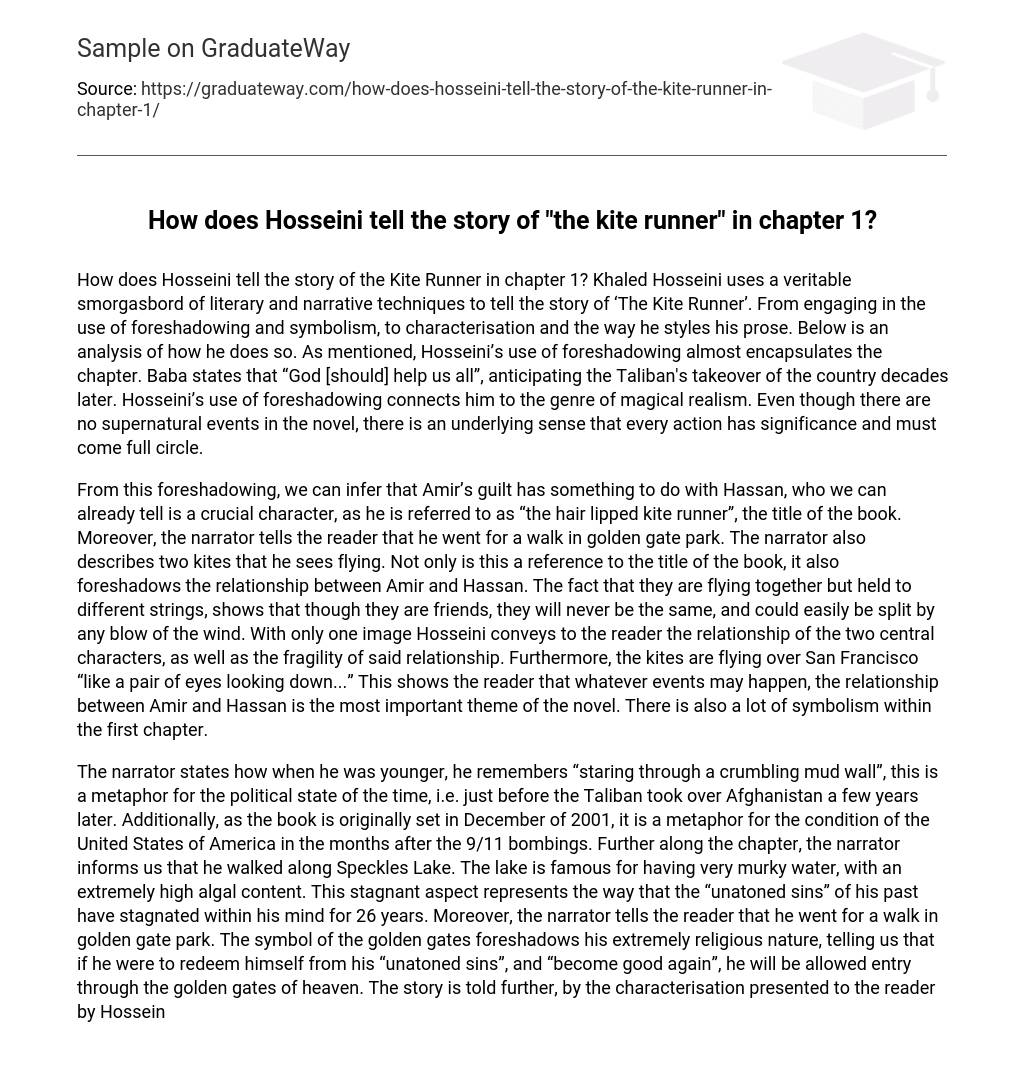How does Hosseini tell the story of the Kite Runner in chapter 1? Khaled Hosseini uses a veritable smorgasbord of literary and narrative techniques to tell the story of ‘The Kite Runner’. From engaging in the use of foreshadowing and symbolism, to characterisation and the way he styles his prose. Below is an analysis of how he does so. As mentioned, Hosseini’s use of foreshadowing almost encapsulates the chapter. Baba states that “God [should] help us all”, anticipating the Taliban’s takeover of the country decades later. Hosseini’s use of foreshadowing connects him to the genre of magical realism. Even though there are no supernatural events in the novel, there is an underlying sense that every action has significance and must come full circle.
From this foreshadowing, we can infer that Amir’s guilt has something to do with Hassan, who we can already tell is a crucial character, as he is referred to as “the hair lipped kite runner”, the title of the book. Moreover, the narrator tells the reader that he went for a walk in golden gate park. The narrator also describes two kites that he sees flying. Not only is this a reference to the title of the book, it also foreshadows the relationship between Amir and Hassan. The fact that they are flying together but held to different strings, shows that though they are friends, they will never be the same, and could easily be split by any blow of the wind. With only one image Hosseini conveys to the reader the relationship of the two central characters, as well as the fragility of said relationship. Furthermore, the kites are flying over San Francisco “like a pair of eyes looking down…” This shows the reader that whatever events may happen, the relationship between Amir and Hassan is the most important theme of the novel. There is also a lot of symbolism within the first chapter.
The narrator states how when he was younger, he remembers “staring through a crumbling mud wall”, this is a metaphor for the political state of the time, i.e. just before the Taliban took over Afghanistan a few years later. Additionally, as the book is originally set in December of 2001, it is a metaphor for the condition of the United States of America in the months after the 9/11 bombings. Further along the chapter, the narrator informs us that he walked along Speckles Lake. The lake is famous for having very murky water, with an extremely high algal content. This stagnant aspect represents the way that the “unatoned sins” of his past have stagnated within his mind for 26 years. Moreover, the narrator tells the reader that he went for a walk in golden gate park. The symbol of the golden gates foreshadows his extremely religious nature, telling us that if he were to redeem himself from his “unatoned sins”, and “become good again”, he will be allowed entry through the golden gates of heaven. The story is told further, by the characterisation presented to the reader by Hosseini. Even in the first chapter we, as the reader are introduced to many of the characters present in the story. We’re told of Rahim Khan, in a way that elevates him above the narrator.
He tells him that “there is a way to become good again.” This implies an informative style of influence over Amir, as we perceive Rahim Khan to know more than Amir. We’re also introduced to Hassan. It is obvious that he will become, if he is not already a pivotal character in the novel, as he is described as “Hassan the hair lipped kite runner,” referencing the title of the novel. We are also told of two other characters: Baba and Ali. These are characters that he “thought” about, meaning they are no longer a part of his life anymore. This could imply that they are dead, or that there was at least a break in their relationship. Lastly, we are told about the narrator himself.
We know that Amir is a very regretful character as he is told he can be “good again,” insinuating that he knows he is bad. We also know that he is a slightly broken individual, as his life, and by extension, he was defined by this moment in the winter of 1975, and this moment was not an enjoyable one. Finally, even by the way the story is told. As it is told in a first person narrative, we as the reader are placed in the mindset of the narrator, meaning that we feel more emotionally connected and to an extent, more empathetic to the narrator. This is extremely effective as by the end of the novel, we come out with the same moral questions as the narrator, with the same answers.
However, the narration in chapter one is also very retrospective. Meaning the narrator knows what will happen, so even from chapter one we as the reader question the motive of the narrator, and are weary as to whether his version of events is biased or not. Hosseini also changes his style of narrative twice within chapter on. It begins with telling the reader what the narrator is thinking, otherwise known as introspective narration. However, he then begins to tell us what happened in the winter of 1975. This retrospective narration is very effective as it allows the operation of hindsight about that the events that transpired within the winter of 1975. As I have shown, multiple aspects of narrative are used by Hosseini to tell the story of Chapter one in the Kite runner and are used extremely effectively to that end. Word count: 1,044





